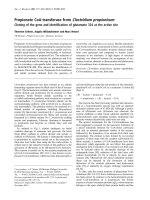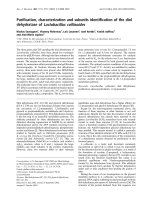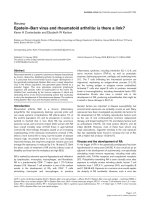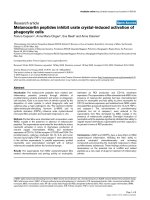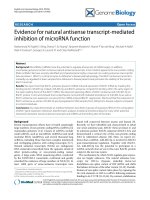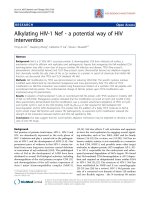Báo cáo y học: " Avian myeoloblastosis virus (AMV): only one side of the coin" ppsx
Bạn đang xem bản rút gọn của tài liệu. Xem và tải ngay bản đầy đủ của tài liệu tại đây (285.68 KB, 5 trang )
BioMed Central
Page 1 of 5
(page number not for citation purposes)
Retrovirology
Open Access
Review
Avian myeoloblastosis virus (AMV): only one side of the coin
Bernard Perbal
Address: Department of Dermatology, University of Michigan Medical School, 1150 W. Medical Center Dr., Medical Science I, Room 6447, Ann
Arbor, Michigan 48109-0609, USA
Email: Bernard Perbal -
Abstract
For many years, scientists and suppliers have refered to AMV-RT as the reverse transcriptase
produced by the Avian Myelobalstosis Virus. This manuscript briefly reviews the molecular basis
for biological dependence of AMV for the envelope and RT proteins that are produced by its
natural helper the Myeloblastosis Associated Virus (MAV). Because the wide use of the term «AMV
RT» obscures scientific facts, it is worthwhile to clarify this issue for the scientific community,
especially for younger scientists who might not be aware of the functional relationships that exist
between these two viruses.
Background
The Avian Myeloblastsis Virus (AMV) is well known
among molecular biologists because AMV stocks have
been used over several decades as one of the major source
of avian Reverse Transcriptase (RT). Originally identified
from Rous Sarcoma Virus (RSV) [1] and Rauscher Leukae-
mia virus (RLV) [2], RT was also found to be an essential
enzyme in the life cycle of other retroviruses and RNA
viruses. The identification of RT with RNA-dependent
DNA polymerase activities has enabled new develop-
ments in many areas of Biology.
In the life cycle of retroviruses, RT transcribes the single
stranded RNA genome into double stranded proviral
DNA, which is integrated into host DNA and from which
viral progeny is made. This process requires three steps,
each catalyzed by the RT enzyme: synthesis of DNA from
the viral RNA template, hydrolysis of the RNA strand
(RNAseH activity), and syntheisis of double stranded
DNA from the single stranded DNA template.
Although it is known for a long time that the rate of
genomic mutation is particularly high among animal ret-
roviruses, this aspect has drawn a lot of attention in the
case of HIV for which the very efficient multiplication of
the virus in vivo is the source of extreme diversity [3].
Mutations that are identified in the viral genome can the-
oretically be introduced at any of the various steps that
lead to proviral DNA either during the synthesis of the
minus-strand cDNA copy of the genomic RNA template,
during the synthesis of the second DNA strand which are
both performed by reverse transcriptase, or during the
transcription of the proviral genome that is performed by
RNA polymerase II. When the relative contribution of
each replication stage to the retroviral mutation rate was
studied with defined templates [4] it was established that
mutations occur mainly at early stages, with a nearly sim-
ilar mutation rate for the two polymerizations catalyzed
by reverse transcriptase. However, these conclusions are
weakened by the fact that the error rates measured in vitro
are approximately an order of magnitude higher than the
overall error rates measured in a single cycle of infection
in cultured cells.
Published: 16 June 2008
Retrovirology 2008, 5:49 doi:10.1186/1742-4690-5-49
Received: 2 May 2008
Accepted: 16 June 2008
This article is available from: />© 2008 Perbal; licensee BioMed Central Ltd.
This is an Open Access article distributed under the terms of the Creative Commons Attribution License ( />),
which permits unrestricted use, distribution, and reproduction in any medium, provided the original work is properly cited.
Retrovirology 2008, 5:49 />Page 2 of 5
(page number not for citation purposes)
The enzyme isolated from AMV-infected cells is composed
of two structurally related sub-units designated α and β
(molecular weights of 65,000 and 95,000 daltons, respec-
tively) assembled into an α β holoenzyme which is gener-
ated by proteolytic cleavage of a minor less active β β
precursor [5,6]. The α subunit of the enzyme has both the
RNA-directed DNA polymerase activity specific to reverse
transcriptase and an RNase H activity. The RNase H activ-
ity is associated with a 24,000-dalton fragment and is gen-
erated by proteolytic cleavage of the α subunit. The
polymerase activity of reverse transcriptase is dependent
on the presence of a primer and a template [7,8].
The AMV RT exhibits a greater processivity than the
murine RT and retains activity at higher temperatures than
the murine RT because of a higher intrinsic thermal stabil-
ity [9]. For these reasons, and because the use of RT in fun-
damental and applied biomedical fields has become
widespread by the introduction of PCR, one of the most
commonly used commercial RT is derived from AMV
stocks.
The viruses
The avian myeloblastosis virus (AMV) is an alpha retrovi-
rus responsible for acute myeloblastic leukemia (AML)
when injected in ovo, or in newly hatched chickens [10].
Early in vitro dose response experiments indicated that
the production of virion with leukemogenic potential
required a double infection with AMV and a helper virus
[11]. The AMV strains that are used and commercially
available, are derived from the orignal BAI strain A puri-
fied from chicken leukemic plasma [12]. Leukemic
plasma containing the BAI strain has been widely distrib-
uted for many years by Life Sciences Inc., in Florida which
has been the official provider of national agencies in the
USA. The Standard AMV-S BAI strain is a complex mixture
of viruses that also includes two helper viruses in addition
to AMV. The helper viruses Myeoloblastosis Associated
Virus (MAV) contained in AMV-S belong to two different
serological subgoups (type1 and type2, also called A and
B). Both of them are oncogenic [13].
Both MAV-1 and MAV-2 are replication-competent retro-
virus with a 7.7 kb genome that encodes seven structural
gag proteins (the viral proteins of the matrix (p19, MA),
capsid (p27, CA) and nucleocapsid (p12, NC), a protease
(p15, PR) and the p1, p2, and p10 proteins of unknown
functions), four pol proteins (95 kDa b and 63 kDa a sub-
units of the reverse transcriptase, the 32 kDa integrase and
a 4.1 kDa peptide of unknown function), and two struc-
tural env glycoproteins [the gp85, surface (SU) and gp37
transmembrane (TM) polypeptides]. Both AMV and MAV
have unique 3' regions (U3) which contain sequences
involved in viral transcription. The U3 region of MAV and
AMV is very similar and does not resemble other retroviral
U3 regions, however, the U5 region of these viruses differs
from that of Rous sarcoma virus (RSV) by only a few base
mismatches.
Early studies have established that plaque-purified MAV
of both types could induce predominantly osteogenic
osteoblastomas and nephroblastomas and less frequently,
visceral lymphoid leukosis [reviewed in ref [13]]. Two
purified strains of MAV2 were reported to have slightly
different oncogenic properties. The MAV2(O) induced
80% osteopetrosis and 20% nephroblastomas whereas
the MAV2(N) induced 80% nephroblastomas and 30%
osteopetrosis [13]. Differences in T1-resistant oligonucle-
otides maps of viral RNAs established that the MAV2(O)
and MAV2(N) strains were genetically distinct.
The acute transforming activity of AMV that results from
the oncogenic properties of v-myb [14] is giving rise to
AML, an infected animals die long before they can
develop tumors that are induced by the MAV component
present in the viral stocks.
Molecular cloning of MAV-1 and MAV-2 proviral
genomes permitted to better define the oncogenic proper-
ties of these viruses and established that genetically pure
MAV2 strains retained their dual pathogenic potential,
when injected in Brown Leghorn chickens (Edinburgh
strain, gs+, chf+, V-), therefore indicating that it did not
result from a mixed population of viruses [15]. The substi-
tution of a single amino acid in the MAV2(O) TM env pro-
tein was proposed to abolish its capacity to induce
osteopetrosis [15].
The MAV1 provirus that was cloned from a library of
leukemic chicken myeloblast DNA [16] was shown to be
of the N type and induce 100% nephroblastomas when
injected either intraveneously in 12-day embryos or intra-
peritoneally to day-old chicken [17]. The highly restricted
oncogenic properties of MAV1(N) made it a unique tool
to study nephroblastoma development at a molecular
level and has led to the discovery of nov/ccn3, which
encode a member of the emerging CCN family of cell
growth regulators [18]. Nucleotide sequencing of the
MAV-1 and MAV-2 proviral genomes identified MAV-1 as
the natural helper of AMV [16] and established that AMV
derived from MAV [19].
The AMV proviral genome that had also been cloned from
peripheral blood leukemic myeloblasts [20] proved to be
significantly different from MAV.
Molecular cloning of the v-myb oncogene [21] and nucle-
otide sequencing of both MAV and AMV proviral genomes
established that in AMV, the insertion of v-myb oncogenic
sequences resulted in the deletion of the entire env gene
Retrovirology 2008, 5:49 />Page 3 of 5
(page number not for citation purposes)
and of the 3' portion of the pol [22] encoding the inte-
grase (IN). The lack of envelope and integrase accounts for
the defectiveness of AMV [reviewed in [23]] (figure 1).
Myeloblasts transformed by purified AMV in the absence
of MAV released defective virus particles which contained
gag proteins but lacked both the env glycoprotein and
transcriptase [24], while cells infected by purified MAV do
Schematic organization and expression the MAV and AMV proviral genomesFigure 1
Schematic organization and expression the MAV and AMV proviral genomes. The MAV RNA genome that is con-
tained in infectious particles is retrotranscribed by RT and viral proteins are expressed from the proviral double stranded
DNA copy of the viral genome, which is integrated into the host genome. The structural glycoproteins (MA, p10, CA, NC, PR)
and reverse transcriptase (POL) are produced by post translational processing of the gag-pol polyprotein precursor, which is
expressed in the form of a bicistronic message (n672-n2777, n2780-n5482) from the proviral genome. The envelope protein is
made from spliced mRNA species that join 17 aminoterminal amino acid residues to the env ORF that begins at nucleotide
5370 of MAV and overlaps the 3' end of the pol gene, encoding the integrase activity (IN). MAV infected cells contain the viral
RNA genome, and both the subgenomic gag-pol precursor and env mRNAs. Cell-derived v-myb oncogenic sequences are
transduced by AMV. Recombination of the truncated c-myb c-DNA copy with the MAV proviral genome occurred within the
pol and env genes of MAV at nucleotides 5372 and 7121, respectively in the proviral DNA of MAV-1. The env splice acceptor
localized upstream to the 5' proximal recombination point in MAV DNA, is used to join the v-myb ORF to the 17 aminotermi-
nal residues of the gag protein. As a consequence of the v-myb integration the AMV is replication defective because it lacks the
gag and pol proteins. Only the genomic viral RNA and the v-myb RNA are expressed from the proviral AMV. The high degree
of conservation between the pol coding sequences which are contained in the MAV genome and the portion of pol sequences
contained in the AMV genome, suggest that recombination between AMV and MAV may occur at this level, and result in the
production of pol proteins from both genomes. However, this has not been demonstrated as yet. top: MAV proviral genome.
Solid boxes represent the LTR sequences which are generated during the process of proviral DNA synthesis and integration.
The gag-pol polyprotein precursor comprises gag sequences (stipled box) and pol sequences (striped box). Proteolytic cleavage
of the precursor occurs at position corresponding to codon 2777–2780. The two black boxes represent the coding sequences
of the envelope protein that are joined by splicingw which occurs between the gag splice donor at nucleotide 689 and the
splice acceptor at position 5370 in the pol sequences. Bottom: proviral AMV genome. The v-myb coding sequences are made of
a part of gag (black box) and c-myb derived sequences (hatched box). Arrows indicate the points of recombination of the c-
myb derived sequences in the MAV genome.
Retrovirology 2008, 5:49 />Page 4 of 5
(page number not for citation purposes)
not produce sufficient virions to make worhtwhile purify-
ing MAV particles for purification of RT.
Upon infection of target cells with both MAV and AMV,
MAV provides in trans the envelope and integrase proteins
that permits i) the production of MAV virions ii) the pro-
duction of pseudotype-1 AMV virions and iii) the integra-
tion of the AMV proviral genome in the host DNA.
Myeloblasts that are transformed by the v-myb protein
proliferate very actively and produce very high titers of vir-
ions which are a mixture of AMV and MAV, with a large
excess of the helper virus that encode a fully active RT.
Discussion
From what is briefly summarized above, it comes that the
RT which is purified from AMV stocks does not originate
from AMV but for the helper virus MAV.
Although both transcriptase and RNAseH activities are
encoded by both viruses, the recombination of v-myb
sequences in AMV interferes with the production of subg-
enomic RNA transcripts encoding these two proteins, as
shown by analysis of viral progeny in purified AMV-
infected cells [24]. The presence of AMV is required to
bring the v-myb oncogene that drive intense proliferation
of transformed myeloblasts that express at the same time
the MAV-encoded proteins. Since recombination between
retroviral genomes has been documented in other sys-
tems, one might argue that recombination occurs between
MAV and AMV genomes in infected cells, leading to the
production of RT by AMV. However, this is very unlikely
as juged by the nucleotide sequences established from sev-
eral independent isolates of MAV and AMV that did not
show any variations with respect to each other.
In spite of these published data, most companies still
claim to provide RT isolated or cloned from pure strains
of AMV. This erroneous understanding of the source of RT
has been propagated throughout the scientific commu-
nity.
Conclusion
What was acceptable in the early days of retrovirology
because of lack of knowledge should be corrected.
We as educators and scientists have the responsibility to
use accurate terminology and disseminate validated con-
cepts. For these reasons, scientists and the numerous RT
suppliers should consider that AMV-RT is a misnomer and
inform those who are unaware of this particlular situa-
tion.
There are many other examples of genes, proteins, or
other biochemical agents that have been given a name,
which is later found to be scientifically inaccurate or mis-
leading. In some cases new knowledge has prompted a
name change to allow persons to use language that is
more accurate. Whether scientists and suppliers might
consider referring to RT as "AMV/MAV RT" instead of
"AMV RT" in lectures, manuscripts and books to avoid
unnecessary confusions might be worth considering.
Acknowledgements
I wish to thank colleagues retrovirologist, or not, who suggested me to
write this short review. It appeared that many of them ignored the molec-
ular basis for AMV and MAV association and did not realize that AMV was
not producing RT. Although most of the data reviewed here has been pub-
lished many years ago, it is always a good time to clarify confusing situations.
I am grateful to M. Baluda who gave me the opportunity to spend two very
productive years in his laboratory at UCLA in the early days of Oncogenes.
Thanks are also due to Pr. Gary Fisher (University of Michigan) for critical
reading of the manuscript and support.
References
1. Temin HM, Mizutani S: RNA-dependent DNA polymerase in
virions of Rous sarcoma virus. Nature 1970,
226(5252):121l-l213.
2. Baltimore D: RNA-dependent DNA polymerase in virions of
RNA tumor viruses. Nature 1970, 226:1209-1211.
3. Coffin J: HIV population dynamics in vivo: implications for
genetic variation, pathogenesis, and therapy. Science 1995,
267:483-489.
4. Kim T, Mudry RA Jr, Rexrode CA 2nd, Pathak VK: Retroviral muta-
tion rates and A-to-G hypermutations during different
stages of retroviral replication. J Virol 1996, 70:7594-7602.
5. Eisenman RN, Mason WS, Linial M: Synthesis and processing of
polymerase proteins of wild-type and mutant avian retrovi-
ruses. J Virol 1980, 36:62-78.
6. Schiff RD, Grandgenett DP: Partial phosphorylation in vivo of
the avian retrovirus pp32 DNA endonuclease. J Virol 1980,
36:889-893.
7. Verma IM: The reverse transcriptase. Biochim Biophys Acta 1977,
473:1-38.
8. Leis J, Duyk G, Johnson S, Longiaru M, Skalka A: Mechanism of
action of the endonuclease associated with the alpha beta
and beta beta forms of avian RNA tumor virus reverse tran-
scriptase. J Virol 1983, 45:727-739.
9. Yasukawa K, Nemoto D, Inouye K: Comparison of the Thermal
Stabilities of Reverse Transcriptases from Avian Myeloblast-
osis Virus and Moloney Murine Leukemia Virus. J Biochem
2008, 143(2):261-268.
10. Beard JW: Avian virus growths and their etiologic agents. Adv
Cancer Res 1963, 7:1-127.
11. Moscovici C, Gazzolo L, Moscovici MG: Focus assay and defec-
tiveness of avian myeloblastosis virus. Virology 1975, 68:173-81.
12. Houts GE, Myagi M, Ellis C, Beard D, Beard JW: Reverse tran-
scriptase from avian myeloblastosis virus.
J Virology 1979,
29:517-522.
13. Perbal B: Pathogenic potential of myeloblastosis-associated
viruses. Infect Agents Dis 1995, 4:212-227.
14. Lipsick JS, Wang DM: Transformation by v-Myb. Oncogene 1999,
18:3047-3055.
15. Joliot V, Boroughs K, Lasserre F, Crochet J, Dambrine G, Smith RE,
Perbal B: Pathogenic potential of myeloblastosis-associated
virus: implication of env proteins for osteopetrosis induc-
tion. Virology 1993, 195:812-819.
16. Perbal B, Lipsick JS, Svoboda J, Silva RF, Baluda MA: Biologically
active proviral clone of myeloblastosis-associated virus type
1: implications for the genesis of avian myeloblastosis virus.
J Virol 1985, 56:240-244.
17. Soret J, Dambrine G, Perbal B: Induction of nephroblastoma by
myeloblastosis-associated virus type 1: state of proviral
DNAs in tumor cells. J Virol 1989, 63:1803-7.
Publish with BioMed Central and every
scientist can read your work free of charge
"BioMed Central will be the most significant development for
disseminating the results of biomedical research in our lifetime."
Sir Paul Nurse, Cancer Research UK
Your research papers will be:
available free of charge to the entire biomedical community
peer reviewed and published immediately upon acceptance
cited in PubMed and archived on PubMed Central
yours — you keep the copyright
Submit your manuscript here:
/>BioMedcentral
Retrovirology 2008, 5:49 />Page 5 of 5
(page number not for citation purposes)
18. Perbal B, Takigawa M, Editors: CCN Proteins: A New Family of
Cell Growth and Differentiation Regulators. Imperial College
Press, London; 2005.
19. Baluda MA, Perbal B, Rushlow KE, Papas TS: Avian myeloblastosis
virus: a model for the generation of viral oncogenes from
potentially oncogenic cellular genetic elements. Folia Biol
(Praha) 1983, 29:18-34.
20. Souza LM, Baluda MA: Identification of the avian myeloblastosis
virus genome. I. Identification of restriction endonuclease
fragments associated with acute myeloblastic leukemia. J
Virol 1980, 36:317-324.
21. Perbal B, Baluda MA: Avian myeloblastosis virus transforming
gene is related to unique chicken DNA regions separated by
at least one intervening sequence. J Virol 1982, 41:250-257.
22. Kan NC, Baluda MA, Papas TS: Sites of recombination between
the transforming gene of avian myeloblastosis virus and its
helper virus. Virology 1985, 145:323-329.
23. Baluda MA, Reddy EP: Anatomy of an integrated avian myelob-
lastosis provirus: structure and function. Oncogene 1994,
9:2761-74.
24. Duesberg PH, Bister K, Moscovici C: Genetic structure of avian
myeloblastosis virus, released from transformed myelob-
lasts as a defective virus particle. Proc Natl Acad Sci USA 1980,
77:5120-5124.

